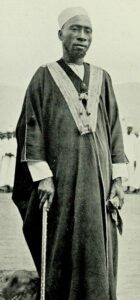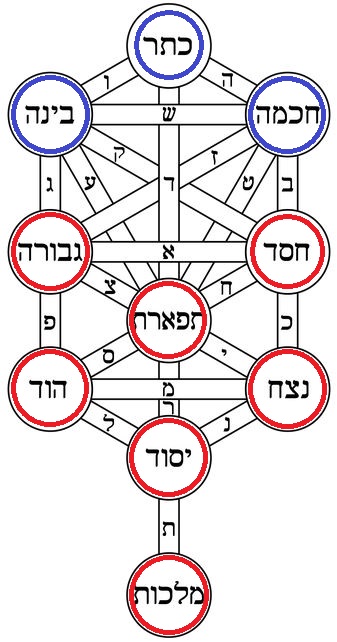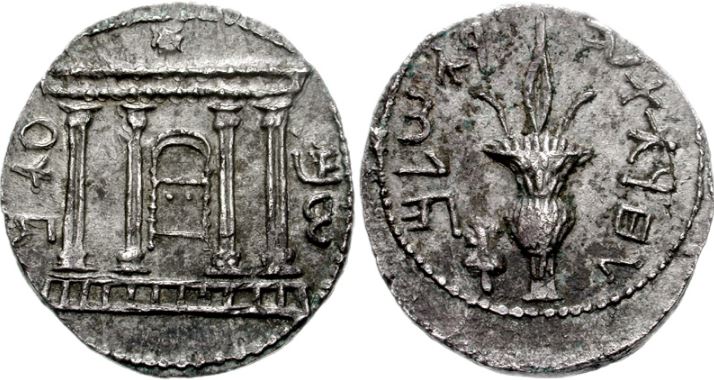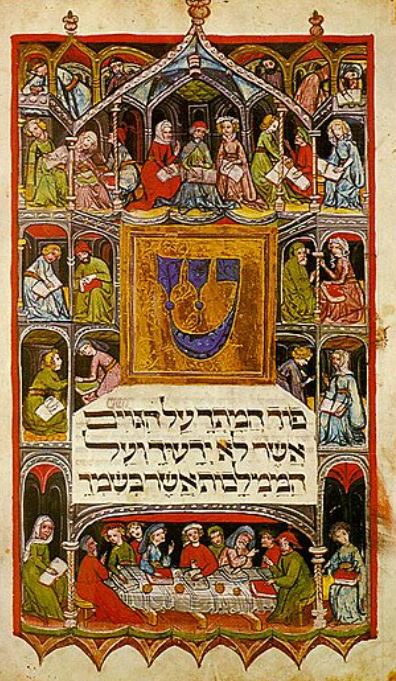The Haftarah for this week’s parasha, Beha’alotkha, is a passage from the prophet Zechariah in which we read that in the End of Days, “many nations will attach themselves to Hashem and become [part of] My people, and I shall dwell among you…” (2:15) This is reminiscent of a more famous verse later in Zechariah: “In those days, ten people from nations of every tongue will take hold—they will take hold of every Jew by a corner of their cloak and say, ‘Let us go with you, for we have heard that God is with you.’” (8:23) What we find in these verses is that in the lead-up to the Messianic Age, many nations will start to realize the truth of Hashem and His Torah and wish to learn with the Jewish people and even become Jews themselves. Today, we are living the fulfilment of this prophecy and witnessing mass-conversions and similar “Judafying” trends all over the world.

Semei Kakungulu
One of the first such notable cases was that of Semei Kakungulu of the Baganda tribe in Africa about a century ago. Kakungulu had converted to Christianity in his youth, before becoming a powerful British-backed chief and warlord. Later in life, Kakungulu took a deep dive into the Bible and started to find inconsistencies and errors in the New Testament. According to legend, he isolated himself in a room and emerged some time later having thrown out the New Testament and declaring only the “Old” to be true. He then circumcised himself and his son and started to live according to Torah law. In 1925, a group of Orthodox Jews passed by Kakungulu’s village, and ended up staying to teach the locals proper Jewish laws and practices, including shechitah and prayer services. By the end of his life, Kakungulu had inspired 8,000 Africans to join him and built a network of 36 synagogues. Despite challenges and persecutions over the subsequent decades, today there are still some 2,000 of them in Uganda (called Abayudaya), and the community is recovering and growing.
A more recent case is that of Segundo Villaneuva of Peru. Like Kakungulu, he found many inconsistencies in the New Testament, and ultimately ended up immersing in Torah. He started his own community, called Bnei Moshe, which soon grew to over 500 people. In 1989, Villaneuva and 160 others completed Orthodox conversions, and the following year made aliyah. Two more waves of conversions and aliyahs followed. Villaneuva’s story inspired many more Latin American communities to embrace Judaism, and it is estimated that there are now 60 such communities across 14 countries in the region.
Parallel to this are many Christian communities that are not abandoning their core beliefs, but still choosing to transition towards traditional Torah observance. This isn’t new, and groups like Seventh-Day Adventists (currently numbered at 21 million around the world) long ago switched to a kosher-style diet and Sabbath observance on Saturday. The Evangelical “Living Church of God”—with 400 congregations around the world and over 10,000 members—commemorate Rosh Hashanah and Yom Kippur, along with the three regalim, and have embraced other Jewish practices. Similar to them are the 8,000 or so Brazilians that are Pentecostal Christians but keep a host of Orthodox Jewish laws, down to circumcision, going to the mikveh, covering their hair, and eating kosher. While these communities still retain their wayward Christian beliefs, they are nonetheless starting to wake up to the truth and shifting in the right direction. Even the Pope said (in a 2018 interview) that more people should keep Shabbat like Jews do! I believe all of this, too, is a fulfilment of Zechariah’s vision.
Of course, mention must be made of the rapidly growing Noahide movement. The Bnei Noach are righteous people who choose to abide by the Torah’s Noahide Laws, without converting to Judaism. It is estimated that there are between 20,000 and 50,000 Noahides around the world today, and the unofficial number could be much higher. The Lubavitcher Rebbe played a key role in launching the Noahide movement, and was particularly adamant about educating non-Jews about the Noahide Laws. He hoped to make the Noahide Laws the backbone of all societies and legal systems, and famously corresponded with President Reagan on this matter.
Rethinking Conversion
Today there are converts to Judaism from all over the globe, from hundreds of different ethnicities and cultures. This includes Palestinians from Gaza, even a former Hamas terrorist, and the famous case of Abraham Sinai, a one-time Shia Hezbollah terrorist who ended up becoming a rabbi! Many African-Americans are converting to Judaism, including the well-known cases of NBA superstar Amar’e Stoudemire (now Yehoshafat) and musician Nissim Black.
This ties right back to our parasha, in which the Torah tells us that Moses married a Cushite woman. While there are certainly numerous differing interpretations of what exactly happened there, the simple pshat seems to be that Moses married a black woman and Miriam apparently had a problem with this. In turn, measure-for-measure, God punished Miriam by making her skin “snow-white” (Numbers 12:10). Perhaps God was sending Miriam a message: you’re not so white yourself! We should remember the words of the prophet Amos (9:7) in which God declares: “Are you children of Israel not like the children of Cush to Me?” (הֲלוֹא כִבְנֵי כֻשִׁיִּים אַתֶּם לִי בְּנֵי יִשְׂרָאֵל נְאֻם־יְהֹוָה) We must not forget that all human beings were made in the image of God, and every person is precious in Hashem’s eyes. Indeed, the Midrash states in several places:
I bring Heaven and Earth to witness that the Divine Spirit may rest upon a non-Jew as well as a Jew, upon a woman as well as a man, upon a maidservant as well as a manservant—all depends on the deeds of the particular individual. (Yalkut Shimoni II, 42; Eliyahu Rabbah 9)
מעיד אני עלי את השמים ואת הארץ, בין גוי בין ישראל, בין איש בין אשה, בין עבד בין שפחה,
הכל לפי מעשיו של אדם רוח הקדש שורה עליו
Just about everyone agrees that we are in the Ikvot haMashiach, on the doorstep of the Messianic Age, and our dear prophets told us long ago to expect in these days that many people will wish to join Israel. We are living this time now, and we must do everything possible to welcome more people into the Jewish fold. The Orthodox world urgently needs to rethink how conversions are carried out: to simplify and soften the process, to remove the unnecessary roadblocks and red tape, and to make it easier (and more pleasant) for people to become Jewish—in fulfilment of prophecy. Let’s not forget what our Sages said in the Talmud that “Israel was exiled among the nations only to draw converts” (Pesachim 87b). Indeed, the actual laws of conversion according to the Talmud, Mishneh Torah, and other ancient halakhic sources is very simple and straight-forward, and could even be done in a single day! If Hillel could famously convert a man “while standing on one foot” (Shabbat 31a), there’s no reason why we can’t.
Some worry about the consequences of such an approach, namely that it will result in inauthentic or “fake” Jews. The truth is, as our Sages state in multiple places, all you need to be considered a bona fide “Jew” is to reject idolatry! In Megillah 13a it says “anyone who spurns idolatry is called a Yehudi” (שֶׁכׇּל הַכּוֹפֵר בַּעֲבוֹדָה זָרָה נִקְרָא ״יְהוּדִי״) while Nedarim 25a says “so grave is idolatry that anyone who rejects it is considered to have acknowledged the entire Torah” (חֲמוּרָה עֲבוֹדָה זָרָה, שֶׁכׇּל הַכּוֹפֵר בָּהּ — כְּאִילּוּ מוֹדֶה בַּתּוֹרָה כּוּלָּהּ). Others pose a similar argument that loosening conversion standards will “dilute” Judaism and result in more secularism and less Torah observance. The reality is that some 90% of the Jewish world is already secular anyway, so what difference does it really make? On the contrary, in absolute terms you will have more potential for Torah observance and Torah learning, plus a larger number of people overall keeping mitzvot and doing good, going to shuls, giving tzedakah, supporting Israel, and so on.
In short, the positives far outweigh the potential negatives. And at the very least, it will lessen the scourge of antisemitism, and will serve to strengthen our nation through sheer numbers. At the moment, Jewish people are easy to pick on because there are very few of us. For instance, we are outnumbered about 100 to 1 by Muslims, and this is one reason why Muslims have little fear in abusing Jews around the world, and why many Jews fear their far-more-numerous Muslim neighbours. In recent months, Jews have sadly been taking down their mezuzot and hiding their Star of David necklaces. This wouldn’t be the case if we weren’t so terribly outnumbered. If every other house in the world had a mezuzah, there would be no fear in displaying one. If half the university was made up of Jewish students, there would be no fear of going to class (nor would there be such flagrant, raging anti-Israel protestors shutting down the campus).
Judaism has never really been a missionary religion, but perhaps it’s time to change that. After all, Moshe Rabbeinu told us that when the nations of the world hear Torah, they will be inspired and say “Surely, this great nation must be a wise and discerning people!” (Deuteronomy 4:6) And Isaiah predicted that in the End of Days, we will no longer be a small people serving God, but shall become a “light unto the nations, so that My salvation should reach the ends of the Earth.” (Isaiah 49:6) The verses are clear and unambiguous: it’s time to spread Torah openly and outwardly, to all the nations, to every corner of the planet. The world is thirsty for it, and needs it now more than ever.
Rav Yitzchak Ginsburgh, too, argues that now is the time for the “Fourth Revolution in Torah Learning”: The first revolution was putting the Oral Law into written form—which had previously been forbidden. Nearly two thousand years ago, the Sages decided it was time to break that taboo and record the Oral Torah. The result, of course, was entirely positive, and resulted in an explosion of Torah learning. The second revolution was allowing Torah to become “one’s trade”, and have full-time Torah scholars and rabbis. This was originally unheard of, and Torah scholars in previous generations all had jobs and businesses of their own. However, changes in society necessitated having dedicated people who are full-time facilitators of Torah and mitzvot for the community. We wouldn’t be able to have the beautiful Jewish communities we have today without full-time rabbis. The third revolution came in the late 1800s, when advanced Torah study was finally opened up for women. Now, Rav Ginsburgh says, we are on the cusp of the fourth revolution, to teach Torah to the non-Jewish world, and this is the key for bringing about the Final Redemption.
Coming back to this week’s parasha, we read that “when a stranger who resides with you offers a Passover sacrifice to God, it must be offered in accordance with the rules and rites of the Passover offering. There shall be one law for you, for the stranger, and the citizen of the land.” (Numbers 9:14) The Torah says that even foreigners and those non-Jews dwelling among us could participate in Passover. Meanwhile, Zechariah describes that following the final war of Gog u’Magog, which will see a coalition of nations from around the world seek to destroy Israel, those same nations will be required to “pilgrimage to Jerusalem from year to year to bow to the King, God of Hosts, and celebrate the holiday of Sukkot.” (14:16) The Torah is inviting the nations of the world to join the Jews. Let’s extend that invitation, welcome with open arms all those who seek Hashem, and bring the whole world one step closer to Geulah.



